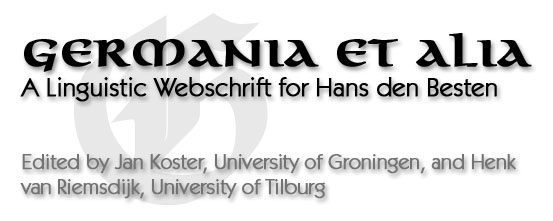|
PREFACE
Hans den Besten is
one of the best linguists of our generation and, arguably, the most
all-round Germanist of all (we can already hear his protests). We became
friends with Hans in the early 1970s when he joined our small group of
generative grammarians at the University of Amsterdam. Even then we were
impressed by Hans’s erudition and knowledge in many different fields.
Slightly eccentric in an endearing way, Hans has always been the admirable
kind of scholar that has become increasingly rare, both inside and outside
of linguistics.
His early work was
focused on verb movements, among other things, and he gave the finishing
touch to what has become the standard analysis of Verb Second phenomena in
Germanic. He contributed to the analysis of numerous other phenomena, both
in Germanic and beyond: hence, the title of this Webschrift. In 1976, at
MIT, he met the South-African linguist Hans du Plessis, who aroused Hans’s
interest in Afrikaans. Afrikaans is a very interesting language for a Dutch
linguist, almost accessible like a native language, but crucially different
from Dutch in many remarkable ways. For political reasons, the study of
Afrikaans was not very popular in those days, almost a taboo in fact. At the
time, Hans was the only Dutch linguist who broke the taboo and became one of
the leading generative students of Afrikaans. Yiddish was also added to
Hans’s arsenal and gradually he became the internationally acclaimed
Germanist we all know and appreciate.
Thanks to his
research on Afrikaans, Hans also became interested in creolization
phenomena, and together with Pieter Muysken and Norval Smith, he formed the
triumvirate that established the undisputed fame of the Amsterdam
linguistics department as Europe’s leading center for the study of Creole
languages in the 1970s and 1980s.
Since Hans has made
valuable contributions to almost every topic in the study of Germanic, it is
practically impossible to single out anything in particular. In addition to
the wide variety of his work in a number of areas,
some of his contributions are classics: the aforementioned analysis
of Verb Second and also Hans’s elucidations of verb clusters in Germanic,
not only as to dialectal variety but also in terms of analytical innovation
(“the third construction”).
As many may know,
Hans’s life has not always been all roses in recent years. He has always accepted his various misfortunes with dignity and in a
rather philosophical way, increasingly also
with humor. In linguistics as well as in his struggle with Parkinson’s
disease, Hans has often been an inspiring example for us.
The immediate
occasion for this festive Webschrift is that Hans has turned 55 on December
18th, 2003. When the idea was first launched, we received
overwhelming positive response from all linguists we approached. For
practical reasons, we have limited the list of contributors to colleagues
who work (or used to work) in Holland. We would like to thank all
participants for their spontaneous and enthusiastic reactions, which is a
measure of the unique stature that Hans enjoys in our community, both as a
linguist and as a friend.
Most important of
all, we warmly congratulate Hans on his 55th birthday and we hope
that he will continue to be our erudite, inspiring and much-appreciated
colleague for many years to come!
Jan Koster
Henk van
Riemsdijk
Back to the Table of Contents
|
